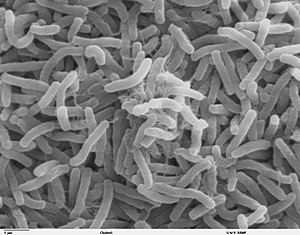 Image via Wikipedia
Image via WikipediaHealth experts have suspected for a while that Haiti's cholera epidemic, which has upset the nation's recovery after the Jan. 12 earthquake, came from a single source. Those suspicions have now been confirmed.
Ever since rumors circulated that the cholera infection was brought into the stricken nation by U.N. sanctioned Nepalese troops, many Haitians have held the U.N. presence in the country responsible. Indeed, there have been attacks on U.N. camps and hospitals by locals.
(See TIME's Top 10 Terrible Epidemics.)
While medical checks proved that it was not the Nepalese who carried the infection, DNA fingerprinting from a sample of Haitian sufferers revealed that the infection in every case was identical. This points to a single source and rules out the possibility of the dormant prevalence of cholera over there.
(See pictures from Haiti's Cholera Outbreak.)
This will not come as good news for Haitians as this still implies that rumors that the U.N. brought in cholera could be true. With over 10,000 different aid agencies employing a working presence in Haiti to provide humanitarian assistance in the aftermath of January's earthquake, it's improbable that the source itself will be identified. However, the result of the international presence does demonstrate the emergence of a catch-22 situation for the humanitarian effort. Bring in more aid and risk further spread of infection or cease the aid effort and risk Haiti devolving into chaos?
(See the Top 10 Deadliest Earthquakes.)
Now that the infection has showed its strength by spreading to the Dominican Republic, is it possible that the outbreak could become an international pandemic? (via Reuters)
Ever since rumors circulated that the cholera infection was brought into the stricken nation by U.N. sanctioned Nepalese troops, many Haitians have held the U.N. presence in the country responsible. Indeed, there have been attacks on U.N. camps and hospitals by locals.
(See TIME's Top 10 Terrible Epidemics.)
While medical checks proved that it was not the Nepalese who carried the infection, DNA fingerprinting from a sample of Haitian sufferers revealed that the infection in every case was identical. This points to a single source and rules out the possibility of the dormant prevalence of cholera over there.
(See pictures from Haiti's Cholera Outbreak.)
This will not come as good news for Haitians as this still implies that rumors that the U.N. brought in cholera could be true. With over 10,000 different aid agencies employing a working presence in Haiti to provide humanitarian assistance in the aftermath of January's earthquake, it's improbable that the source itself will be identified. However, the result of the international presence does demonstrate the emergence of a catch-22 situation for the humanitarian effort. Bring in more aid and risk further spread of infection or cease the aid effort and risk Haiti devolving into chaos?
(See the Top 10 Deadliest Earthquakes.)
Now that the infection has showed its strength by spreading to the Dominican Republic, is it possible that the outbreak could become an international pandemic? (via Reuters)
Lifted from this article:
Haiti's Cholera Epidemic: Infection Came from 'Single Source'
Related articles
- Aid Groups Slam 'Inadequate' Haiti Cholera Response, Funding (devex.com)
- No let-up in Haiti cholera one week from elections, AFP reports (repeatingislands.com)
- Haiti's cholera part of old pandemic, CDC says (reuters.com)
- Haiti cholera pandemic started 49 years ago (thestar.com)
- No let-up in Haiti cholera one week from elections - AFP (news.google.com)
- Haiti battles to control cholera epidemic as protests gain momentum - The Guardian (news.google.com)
- Cholera fighting efforts restart in Haiti's north (reuters.com)
- Is the UN responsible for Haiti's cholera epidemic? (beyondanomie.wordpress.com)
- Analysis: Whodunnit? Officials have sticky problem in Haiti (reuters.com)
- Source of Haiti's cholera outbreak may never be known - MiamiHerald.com (news.google.com)

